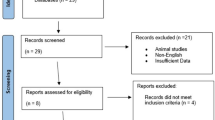Abstract
In septic joint surgery, the most frequently used antiseptics are polyhexanide, hydrogen peroxide and taurolidine. The aim of this study was to examine the effects of these antiseptics on viability of human chondrocytes. Our hypothesis was that antiseptics and supplemental irrigation with sodium chloride lavage are less toxic on human chondrocytes than treatment with antiseptics only. Primary human chondrocytes were isolated and cultured from six donated human knee joints. Polyhexanide, hydrogen peroxide or taurolidine were added to the cultures. Toxicity analysis was performed by visualisation of cell structure using light microscopy and LDH activity. The determination of vital cells and total cell numbers of chondrocytes treated with antiseptics partly followed by irrigation with sodium chloride solution was performed by using Casy Cell-Counter. Light microscopic data revealed a defect in cell structure after addition of antiseptics. We showed a significant increase of LDH enzyme activity after the treatment with polyhexanide or taurolidine. After treatment with antiseptics followed by sodium chloride solution a significant increase of vital and total cell numbers resulted in comparison with the chondrocytes that were only treated with antiseptics. The data show that treatment with polyhexanid, hydrogen peroxide or taurolidine induces cell death of human chondroctes in vitro. The application of sodium chloride solution after the treatment with polyhexanide and hydrogen peroxide possibly has a protective effect on chondrocyte viability.




Similar content being viewed by others
References
Stutz G, Gächter A (2001) Diagnostik und stadiengerechte Therapie von Gelenkinfekten. Unfallchirurg 104:682–686
Armstrong RW, Bolding F, Joseph R (1992) Septic arthritis following arthroscopy: clinical syndromes and analysis of risk factors. Arthroscopy 8:213–231
Riegels-Nielsen P, Frimodt-Möller N, Jensen J (1987) Rabbit model of septic arthritis. Acta Orthop Scand 58:14–19
Ryan MJ, Kavanagh R, Wall PG, Hazleman BL (1997) Bacterial joint infection in England and Wales: analysis of bacterial isolates over a four year period. Br J Rheumatol 36:370–373
Smith M (1986) Arthroscopic treatment of the septic knee. Arhtroscopy 2:30–34
Charalambous CP, Tryfonidis M, Sadiq S, Hirst P, Paul A (2003) Septic arthritis following intra-articular steroid injection of the knee—a survey of current practice regarding antiseptic technique used during intra-articular steroid injection of the knee. Clin Rheumatol 22:386–390
Von Essen R, Savolainen HA (1989) Bacterial infection following intra-articular injection—a brief review. Scan J Rheumatol 18:7–12
Atiyeh BS, Dibo SA, Hayek S (2009) Wound cleaning, topical antiseptics and wound healing. Int Wound J 6:420–430
Drosou A, Falabella A, Kirsner RS (2003) Antiseptics on wounds: an area of controversy. Wounds 15:149–166
Hirsch T, Seipp HM, Jacobson F, Goertz O, Steinau HU, Steinstraesser L et al (2010) Antiseptics in surgery. Eplasty 10:320–326
Kalteis T, Lüring C, Schaumburger J, Perlicl L, Bäthis H, Grifka J (2003) Gewebetoxizität lokaler Antiseptika. Z Orthop 141:233–238
Schaumburger J, Beckmann J, Springorum HR, Handel M, Anders S, Kalteis T, Grifka J, Rath B (2010) Toxitität lokaler Antiseptika auf Chondrozyten in vitro. Z Orthop Unfall 14:839–843
Röhner E, Detert J, Kolar P et al (2010) Induced apoptosis of chondrocytes by Porphyromonas gingivalis as a possible pathway for cartilage loss in rheumatoid arthritis. Cal Tiss Int 87:333–340
Simon U (1997) Programmierter Zelltod. Dtsch Med Wschr 122:167–168
Bühling K, Lepenies J, Witt K., 2004. Intensivkurs Allgemeine und spezielle Pathologie. 3. Auflage, Urban und Fischer, München
Walker NI, Harmon BV, Gobe GC, Kerr JV (1988) Patterns of cell death. Methods Achiev Exp Pathol 13:18–54
Lo MY, Kim HT (2004) Chondrocyte apoptosis induced by hydrogen peroxide requires caspase activation but not mitochondrial transition. J Orth Res 22:1120–1125
Ince A, Schütze N, Hendrich C, Jakob F, Eulert J, Löhr JF (2007) Effect of polyhexanide and gentamicin on human osteoblasts and endothelial cells. Swiss Med Wkly 137:39–145
Disclosure statement
The authors have no proprietary, financial, professional or other personal interest of any nature or kind in any product, service and/or company that could be construed as influencing the results and views presented in this article.
Author information
Authors and Affiliations
Corresponding author
Rights and permissions
About this article
Cite this article
Röhner, E., Kolar, P., Seeger, J.B. et al. Toxicity of antiseptics against chondrocytes: What is best for the cartilage in septic joint surgery?. International Orthopaedics (SICOT) 35, 1719–1723 (2011). https://doi.org/10.1007/s00264-010-1178-2
Received:
Revised:
Accepted:
Published:
Issue Date:
DOI: https://doi.org/10.1007/s00264-010-1178-2




